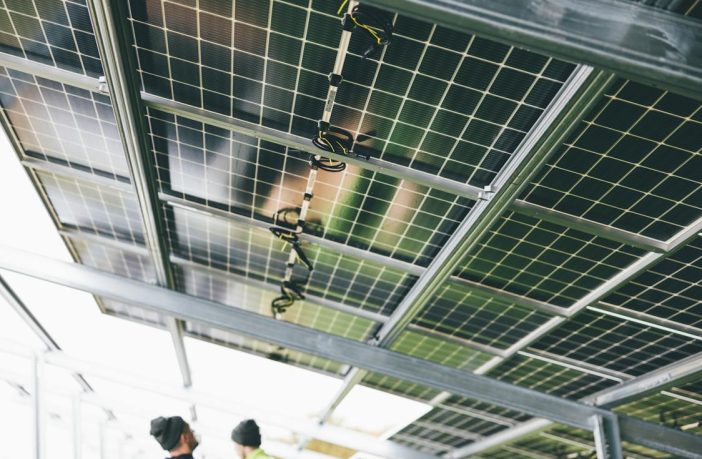Open-Ed
- Light, strong, and highly recyclable, aluminum is a first choice for many climate-tech applications.
- But its current climate toll is substantial. Here are key steps to get that to zero.
You might know aluminum from the cans you throw in the recycling after a party, but the metal is not just essential to the beverage industry. Aluminum’s lightweight yet strong properties make it indispensable to a range of industries, from cars to airplanes to solar panels.
But that versatility comes at a cost. The aluminum industry is responsible for roughly 2 percent of global greenhouse gas (GHG) emissions. The vast majority of those emissions come from producing the metal from bauxite ore using coal-fired electricity (China, the world’s largest aluminum producer at 55 percent of global production, is also emissions-intensive). But aluminum’s reliance on electricity makes it ripe for rethinking and charting a path toward a renewables-powered future.
Chart: RMI Data: International Aluminum
And that can’t come at a moment too soon: aluminum’s centrality to the energy transition is poised to increase consumption by between 50 and 80 percent by 2050, all while aluminum’s emissions need to drop by 77 percent to stay within a 1.5°C pathway.
Of course, the most climate-friendly aluminum is produced using the least energy, and that’s where the metal has a distinct advantage. Endlessly recyclable, aluminum that is reused has a much smaller carbon impact. However, recycling will not decarbonize the sector alone as scrap is not enough to meet the growing demand for aluminum.
So in order for this essential industry to thrive in a net-zero world we need two things to happen: aluminum production from raw materials must switch to renewable sources, and recycling rates need to increase dramatically.
RMI is focused on solving both of these challenges simultaneously by working directly with both aluminum producers to increase transparency in their processes as well as the financial institutions that will need to finance nearly $1 trillion in additional investment required to transition the sector to renewable energy and reach net zero by 2050.
Getting granular on recycling
Not all recycled aluminum is equal. In order to decarbonize the aluminum sector, it’s important to separate out post-consumer aluminum (i.e., your empty soda can) from pre-consumer aluminum (the wasted ends of aluminum sheeting on the can’s factory floor). The industry term for these “waste” products is scrap.
On the pre-consumer side, to reach net zero, manufacturing needs to become more efficient so that extra aluminum isn’t produced in the first place. Although this is eventually recycled, we must reduce this pre-consumer scrap from 13 percent to 9 percent of production by 2050 to reach net zero.
On the post-consumer side, much more can be done. A European study found that roughly 28 percent of beverage cans on the continent end up in landfills or incinerators. On a global scale, the use of post-consumer scrap in aluminum production needs to jump from 21 percent to 46 percent by 2050 to stay in line with net-zero goals.
RMI is helping speed this process along with the urgency it requires by working with aluminum producers to increase transparency for aluminum buyers.
To incentivize the use of more post-consumer scrap, it is important to know what percentage of an aluminum product’s inputs are from this end-of-life scrap. Currently, most aluminum producers just report the total recycled content in their aluminum products, making it impossible to know whether or how much post-consumer scrap was used. To overcome this challenge, buyers of aluminum products are increasingly requesting more information on the share of post-consumer scrap in their purchased products.
RMI’s Aluminum GHG Emissions Reporting Guidance encourages separate disclosure of the different types of scrap aluminum that get made into end products — incentivizing buyers to support the kinds of recycling we need.
Better reporting, better outcomes
The guidance doesn’t stop at recycling however, it also enables producers to account for and disclose the emissions intensity of their products — gaining a competitive advantage in meeting corporate buyer demand for emissions transparency.
RMI aims to match sustainable aluminum supply and demand by making it possible to report precisely where emissions are coming from in the supply chain. This precision equips banks and other financial institutions with the information they need to direct capital to low- or zero-carbon emissions aluminum technologies and projects, it also empowers corporate buyers with the information they need to make procurement decisions to drive demand for low-carbon aluminum.
The road ahead
Equipping aluminum producers with the tools they need to transition to net-zero production will take vast amounts of capital, as well as a renewed focus on recycling. RMI is working up and down the aluminum value chain to advance these goals in this critical decade.
Authors: Nicole Labutong, Wenjuan Liu
This article was originally published by the RMI and is republished with permission through the Creative Commons CC BY-SA 4.0 license.
Disclaimer: The articles expressed in this publication are those of the authors. They do not purport to reflect the opinions or views of Green Building Africa or our staff. The designations employed in this publication and the presentation of material therein do not imply the expression of any opinion whatsoever on the part Green Building Africa concerning the legal status of any country, area or territory or of its authorities.















